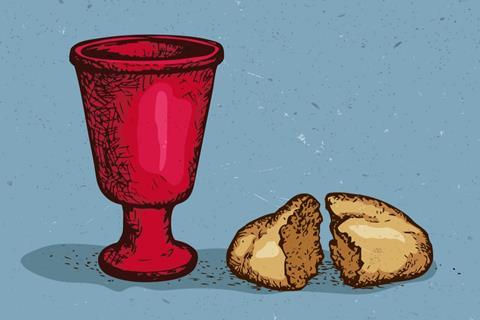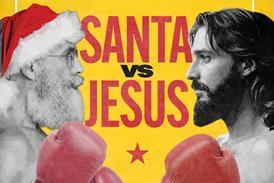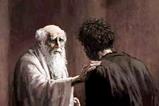Traditions may have changed over the centuries, but wherever and whenever we eat the bread and drink the wine, we share fellowship together as one family – and with Jesus – says David Instone-Brewer

It was tough for both Christians and Jews in the Roman world. For Jews, it was difficult to keep the purity laws and find kosher food in a pagan land. For Christians, it was hard to live in a righteous way and find opportunities to worship. Today, our practice of meeting on Sunday and our communion service still bear evidence of their struggles and how Jewish practices helped deal with them.
On the Sabbath (from Friday sunset to Saturday), Jews were forbidden to do any work – which even included carrying chamber pots out of their homes. Fortunately, the rabbis found a way of extending the area in which you were allowed to carry things by grouping houses together as a single ‘home’.
Houses in Rome tended to be built around a common courtyard where the midden (rubbish) heap was kept. If the courtyard became part of that home, carrying domestic waste to it was perfectly acceptable, even on a Sabbath. This workaround required the households to be regarded as part of the same family, and to demonstrate this they put aside some shared food, which they ate at the end of the Sabbath – in particular, a loaf of bread called the eruv.
Becoming one
Paul recognised that for Christians, too, sharing bread together united them as a family: “Because there is one bread, we who are many are one body” (1 Corinthians 10:17, ESV). For Christians, of course, this loaf also represented Christ’s body broken for them. And like many Jews meeting together to eat the eruv loaf, Christians made this into a communal meal by bringing along other food. They also regarded themselves as a single household, meeting in houses (Romans 16:5; 1 Corinthians 16:19; Colossians 4:15) and calling each other adelphoi – ‘siblings’. They were family.
In Rome, the poor lived in apartment blocks – a type of architecture that was invented there. Most were six or even ten storeys high and had very small rooms. This enabled Rome to become the first city ever to have 1 million inhabitants. Jews living in apartments could also create a single household that shared an outdoor midden, provided they shared an eruv loaf together with other Jews in the same block. Christians, too, found it easier to live in blocks with other believers; it enabled them to share the gospel with their neighbours by inviting them in to worship with them.
One of these apartment blocks has survived. Situated on the side of a roundabout near the Forum, it isn’t developed as a tourist attraction, but those who stop to look get a surprise. Staring up into one apartment, you can see the inside walls remain lavishly decorated with clearly Christian images – the work of an early Christian artist in an apartment believers used as a church (see tinyurl.com/ApartmentChurch).
Meeting together
The communal meals enjoyed by Christians and Jews occurred at about the same time. Christians used to worship on a Sabbath (Acts 13:42, 44; 16:13) but, at some point, the day changed. Perhaps this was because Jesus rose on a Sunday, although no ancient text gives this reason. I think it more likely that churches began to meet on a Sunday after Christians started meeting on the evening of the Sabbath, in order to allow domestic slaves to attend after their owner no longer required them. By Jewish reckoning, Sunday started after sunset on Saturday evening.
This agrees with what the anti-Christian writer Celsus said about the Church making concessions for slaves – for which he ridiculed them (The True Word 3:44). Evening meetings are also implied by the fact that they met for a meal (Jude 12; 1 Corinthians 11:2-22), because Romans didn’t have communal lunches or breakfasts.
In Acts 20, Paul is still speaking at midnight – which was undoubtedly unusual – but the text implies there was nothing abnormal about meeting in the evening: “On the first day of the week, when we were gathered together to break bread, Paul talked with them, intending to depart on the next day, and he prolonged his speech until midnight” (Acts 20:7, ESV).
It became normal for Christians to meet in the evening at the start of Sunday (1 Corinthians 16:2) – though some preferred to keep meeting on the Sabbath (Colossians 2:16). So, Christians were eating together at the same time that extended Jewish households met to eat the eruv!
Fellowship with God
Paul said communion was also similar to the meal eaten by priests in the temple: “The cup of blessing that we bless, is it not a participation in the blood of Christ? The bread that we break, is it not a participation in the body of Christ?…are not those who eat the sacrifices participants in the altar?” (1 Corinthians 10:16-18, ESV).
The word ‘participation’ is koinonia – often translated as ‘fellowship’. “Fellowship with the altar” sounds strange, but ‘altar’ in this context is a substitution for ‘God’. It is like saying ‘kingdom of heaven’ instead of ‘kingdom of God’. Paul was saying that we can have fellowship with God just like the priests in the temple who ate the bread and drank the wine on “the table of the bread of the Presence” (Numbers 4:7, ESV). Since they did this after bringing new bread on the Sabbath (Leviticus 24:8), they also probably consumed this at the same time as Christians!
When Jesus called the meal a ‘remembrance’, It isn’t in the modern sense of a memorial for a dead person
When Jesus called the meal a “remembrance” (Luke 22:19), it isn’t in the modern sense of a memorial for a dead person. Old Testament memorial offerings remind us who God is (Numbers 10:10), so this meal is to remind us that Jesus is still with us.
Practices change with time. Believers now meet later on Sunday, so breaking bread together isn’t an evening celebration, and we no longer bring food along, so it isn’t a meal. And most of us don’t meet in houses. But the most important details of this special act are still the same as they were in the earliest days of the Church. We share fellowship as one family together, with each other and with the risen Jesus.







































No comments yet